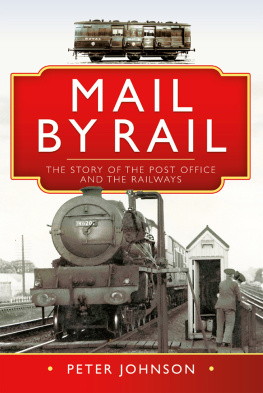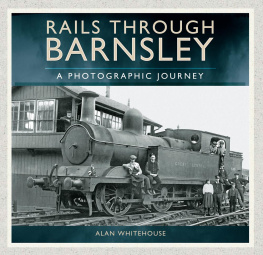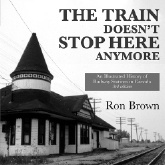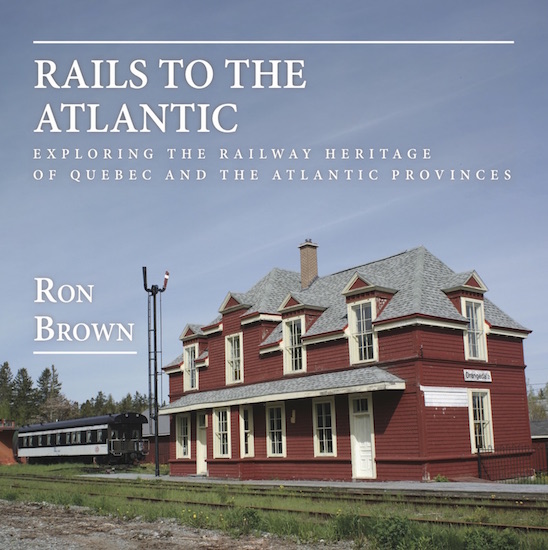Copyright
Copyright Ron Brown, 2015
All rights reserved. No part of this publication may be reproduced, stored in a retrieval system, or transmitted in any form or by any means, electronic, mechanical, photocopying, recording, or otherwise (except for brief passages for purpose of review) without the prior permission of Dundurn Press. Permission to photocopy should be requested from Access Copyright.
Editor: Michael Melgaard
Design: Courtney Horner
Cover image: Ron Brown
Epub Design: Carmen Giraudy
Library and Archives Canada Cataloguing in Publication
Brown, Ron, 1945-, author
Rails to the Atlantic : exploring the railway heritage of Quebec
and the Atlantic provinces / Ron Brown.
Includes bibliographical references and index.
Issued in print and electronic formats.
ISBN 978-1-4597-2877-6 (pbk.).--ISBN 978-1-4597-2878-3 (pdf).-
ISBN 978-1-4597-2879-0 (epub)
1. Railroads--Qubec (Province)--History. 2. Railroads--Atlantic
Provinces--History. I. Title.
TF26.B76 2015 385.09714 C2015-902077-8
C2015-902078-6
We acknowledge the support of the Canada Council for the Arts and the Ontario Arts Council for our publishing program. We also acknowledge the financial support of the Government of Canada through the Canada Book Fund and Livres Canada Books, and the Government of Ontario through the Ontario Book Publishing Tax Credit and the Ontario Media Development Corporation.
Care has been taken to trace the ownership of copyright material used in this book. The author and the publisher welcome any information enabling them to rectify any references or credits in subsequent editions.
J. Kirk Howard, President
The publisher is not responsible for websites or their content unless they are owned by the publisher.
Visit us at: Dundurn.com | @dundurnpress | Facebook.com/dundurnpress | Pinterest.com/dundurnpress
Acknowledgements
W ith a work that covers such an expanse of territory as this, I needed to consult many individuals and organizations that provided assistance both with key information and with field logistics. I would like to start by thanking Gillian Hall of the Toronto office of Tourisme Quebec. She and her staff provided important contacts and generous assistance in many respects.
In the field, help was provided by many people and organizations. In no particular order, these include: Genevieve Parent of the spectacular Fairmont Chateau Frontenac in Quebec City; Debbie Starr of the historic Lord Nelson Hotel and Suites in Halifax; Denise Bradbury of the Algonquin Resort, St. Andrews by-the-Sea in New Brunswick; Glenn Bowie of the Westin Nova Scotian Hotel in Halifax; Andrew Phillips and Paul Lalonde of the Nova Scotia Museum of Industry in Stellarton; Anne Chardon of Outaouais Tourisme; Elsie Carroll of the beautiful McAdam, New Brunswick, Railway Station; Paula Wamback of the Nova Scotia Tourism Agency; Simon Leguerre of the Socit de dveloppement du Tmiscamingue; Matthieu Tremblay of the Rseau Charlevoix; Marie Michele Cloutier of Les Htels JARO in Quebec City; Paul Bergeron of Quebec City Tourisme; Marisa Iaconelli of Tourisme Montreal; Magalie Barton of Tourisme Quebec; Louis-Antoine Paquin of CN Rail; Jennifer Burnell of Parks Canada; Alison Aiton of New Brunswick Tourism; Nathalie Beauchamp of the Fairmont Chateau Montebello; Pierre Bessette of Tourisme Quebec; Allan Bailey and Claude Chartrand of La Socit dHistoire de Senneterre; and Susan Goertzer, tour manager of Ministers Island.
I am grateful also to the proprietors of Auberge du Village in Shawville, Quebec; Auberge Eugene in Ville-Marie, Quebec; the bed and breakfast Le Voyageur in Saint-Jovite, Quebec; the New Brunswick Division of the Canadian Railroad Historical Association; the Shawville-Pontiac Historical Society; the Coastal Inn in Antigonish, Nova Scotia; and a special shout-out to my cousins Charles Millard and Paula Millard for their gracious hospitality.
Introduction
Celebrating the Legacy
The Canada we know today was largely built around railways, but how easily the country ignores that heritage. We demolish stations, we toss aside vital rail passenger service, and we have raised a younger generation that has never ridden a train.
Before the rails arrived in the 1830s, we were a widely dispersed population, clustered around ports, mill sites, farm hamlets, or, in the case of our First Nations, relegated to scattered settlements. But railways linked those places to the rest of Canada and provided access for everyone. As the rail network expanded, new communities were created. This growth was most notable across the Prairie provinces and through northern Ontario and Quebec, where entire towns appeared thanks to the railways. Speedy rail movement allowed the economy to boom. Rail towns became bustling commercial hubs.
Railway expansion lasted more than a century. The first trains began their work in the coal fields of Nova Scotia in the 1830s, using wooden steam engines that survive today in Stellartons Museum of Industry. These industrial spurs expanded into longer rail lines that opened up large tracts of eastern Canada. Major rail lines the National Transcontinental (NTR), the Canadian Northern (CNoR), and the Canadian Pacific (CPR) made their way west from the east coast, while regional lines like the Intercolonial (ICR), the Grand Trunk (GTR), and the Quebec Central Railways (QCR) created a spiders web of steel throughout the hinterlands of Quebec and the Maritimes. Railway charters by the hundreds came and went, many amalgamated into or assimilated by ever-larger rail corporations. Meanwhile, the island provinces of Prince Edward Island and Newfoundland (then a colony) enjoyed their own separate rail lines.
Rail lines created a special landscape. Divisional points appeared at 150 kilometre intervals to provide assembly yards for the trains, maintenance for the engines and rolling stock, and housing for railway employees. Water towers, coal chutes, grain elevators, and warehouses became part and parcel of the emerging Canadian landscape. Everything hinged upon the railways.
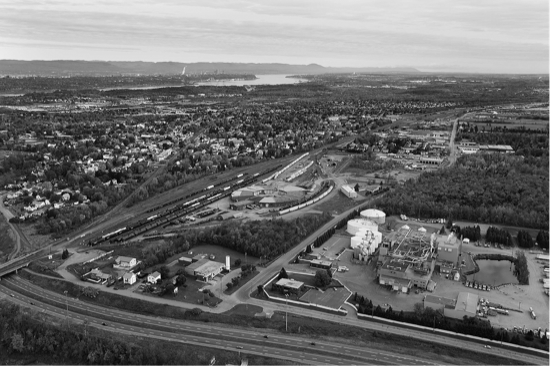
Charny was a major railway hub created by the Grand Trunk Railway. The large roundhouse and yards are visible in the foreground. (Photo courtesy CN Rail.)
But the face of the railways were the stations. A citys main street often led straight up to the door of the station. Here, the rail lines put to work some the eras leading architects to create attractive, even spectacular, station buildings intended to lure travellers from competing lines. It was here, after all, that the townsfolk picked up their mail, listened to news on the station wire, bade farewell to loved ones going to war, and, if lucky, greeted them upon their return. Everything from mail to milk to livestock to Christmas presents was shipped from these important points.








